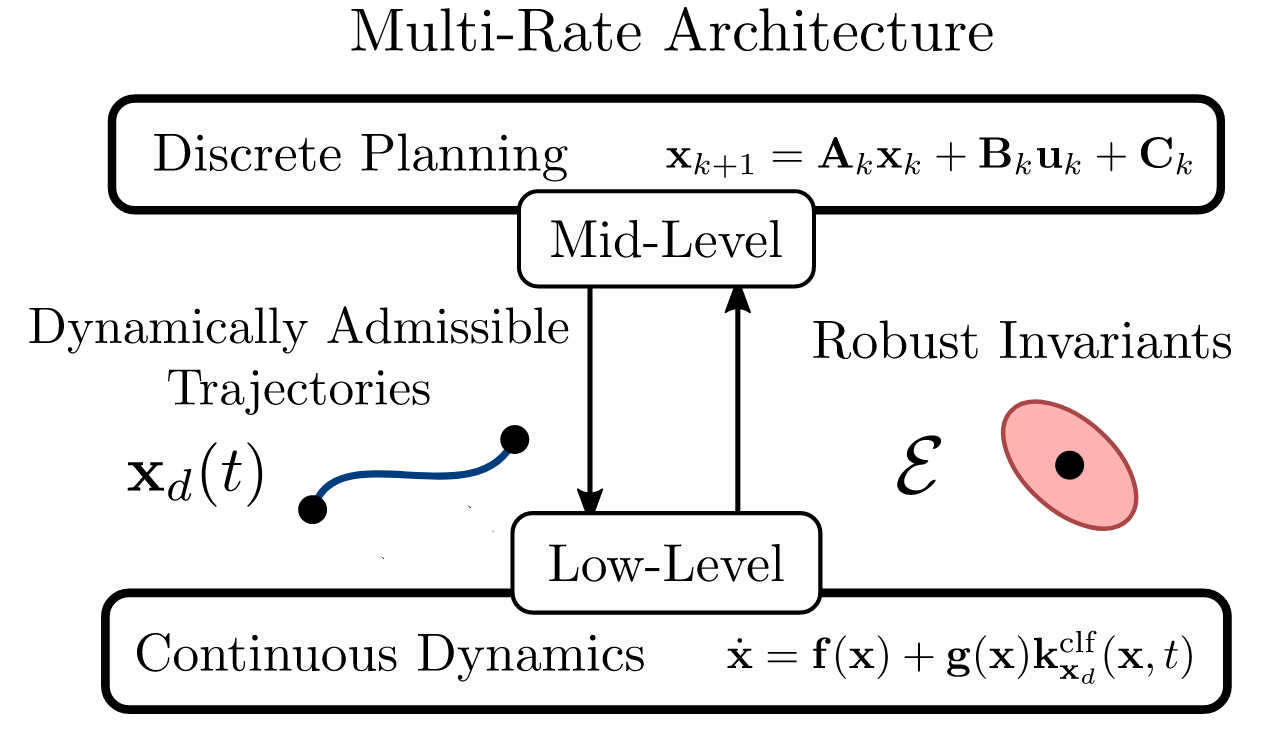The following discussion is meant to be a more illustrative exposition of the methodology employed in the paper: Multi-Rate Planning and Control of Uncertain Nonlinear Systems: Model Predictive Control and Control Lyapunov Functions, while answering some potential questions that may arise.
Table of Contents
Motivation
Before getting into the weeds, we will motivate the use of robust linear MPC, which will start with a discussion of linear MPC.
Linear MPC
First consider the deterministic linear conrol system with discrete time dynamics \[x_{k+1} = Ax_k + Bu_k\] with \(x\in \mathbb{R}^n\), \(u\in\mathbb{R}^m\), \(A\in\mathbb{R}^{n\times n}\), and \(B\in\mathbb{R}^{n\times m}\). The standard MPC program can be written as:
\begin{align}
u^* = \,\,\underset{u \in \mathbb{R}^m}{\text{argmin}} & \quad \sum_{k=0}^{N-1} x_k^\top Q x_k + u_k^\top R u_k + x_N^\top V x_N \notag\\ \notag
\mathrm{s.t.} \quad & \quad x_{k+1} = Ax_k + Bu_k \\ \notag
&\quad x_0 =x(0) \\ \notag
&\quad x_k \in \mathcal{X}\\ \notag
&\quad u_k \in \mathcal{U}\\ \notag
&\quad x_N \in \mathcal{X}_F, \nonumber
\end{align}
for \(Q\in\mathbb{R}^{n\times n}\), \(R\in\mathbb{R}^{m\times m}\) state and input weights, \(V\in\mathbb{R}^{n\times n}\) terminal cost, \(\mathcal{X}\subset \mathbb{R}^n\), \(\mathcal{U}\subset\mathbb{R}^m\), state and input constraints, and respectively, and \(\mathcal{X}_F\subset\mathbb{R}^n\) the terminal constraint set. For the sake of simplicity, we will start by assuming that the terminal constraint set is given by a point, i.e. \(x_e = \mathcal{X}_F\), which is a control invariant with control input \(u=0\).
Solving this optimization problem at time $t=0$ results in the optimal solutions:
\begin{align}
x^* &= \{x^*_{0|0},\ldots,x_e\}\notag \\
u^* &= \{u^*_{0|0},\ldots,u^*_{N-1|0}\}, \notag
\end{align}
where \(x_{k|t}\) represents the \(k^{th}\) state decision variable as planned at time index $t$, as depicted by:


u^* &= \{u^*_{1|0},\ldots,u^*_{N-1|0}, 0\}, \notag
\end{align}
are feasible at time step \(t=1\) (again, assuming that \(x_e\), the terminal constraint set is a control invariant with control input \(u=0\). In general this idea can be extended to terminal constraints of arbitrary [polytopic, or more generally, convex] terminal constraints \(\mathcal{X}_F\)). To see this, consider the set \(\mathcal{X}_F\), a control invariant under the policy \(\pi:\mathbb{R}^n\to\mathbb{R}^m\). In the recursive feasability step, we can replace the state action pairs with:
\begin{align}
x^* &= \{x^*_{1|0},\ldots,x_{N|0}, Ax_{N|0} + B\pi(x_{N|0})\}\notag \\
u^* &= \{u^*_{1|0},\ldots,u^*_{N-1|0}, \pi(x_{N|0})\}, \notag
\end{align}
Robust Linear MPC
This is all fine and dandy, but now consider the uncertain system dynamics of \[x_{k+1} = Ax_k + Bu_k + w\] for \(w\in\mathcal{W}\subset\mathbb{R}^n\). In this setting, two things are lost:
- It may be that the system state exits the state constraint set
- We no longer have a guarantee of recursive feasibility
In order to remedy these issues, we have a few options. The first option is to plan policies over the disturbance set (more details can be found in this paper). It is not clear how to do this for general systems, but for linear systems with polytopic disturbance sets \(\mathcal{W}\), this can be achieved via an optimization program that is NP-hard to solve. Another option, which will naturally extend to nonlinear systems, is to use a feedback controller in tandem with MPC.
We start by defining a feedback policy \(K\in\mathbb{R}^{m\times n}\) which renders the closed loop system \(A_{\textrm{cl}} = A+BK\) stable. We can then generate a robust invariant \(\mathcal{E}\), i.e. a set such that for all elements \(x^-\in\mathcal{E}\), there exists an input \(u\) such that the point \(x^+ = Ax^-+Bu + w \in \mathcal{E}\) for all \(w\in\mathcal{W}\). The process of producing such a robust invariant for linear systems is depicted below, with more details in this paper.



This paradigm of separating the feedback to a “low-level” controller, allowing the MPC program to plan over the disturbance free system is the same idea as employed in my most recent paper), which extends this concept to nonlinear systems:
